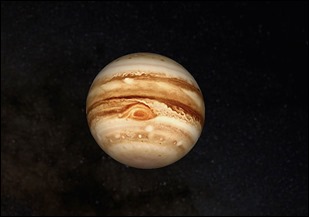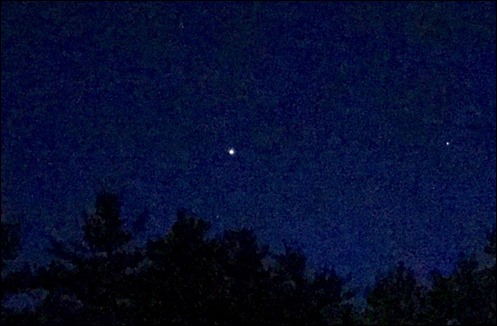It is a great week for night stargazing and sky watching – #Jupiter
Posted By RichC on June 12, 2019
Just north of Cincinnati the sky was perfect for viewing the rise of Jupiter as the sky darkened about 9:30PM. The bright dot (photo below from my iPhone)  rose in the SE sky and arched slowly until reaching its highest point due south at about 12:30AM and then moved lower well after I was in bed.
rose in the SE sky and arched slowly until reaching its highest point due south at about 12:30AM and then moved lower well after I was in bed.
Viewing the night sky reminded me of spending cool evening in the backyard with my daughter Katelyn when she was younger. She took an interest in astronomy and even bought her own telescope when other teenager girls were shopping for purses, shoes and make-up (not that she did without).
As I was in and out of the house several times watching the bright and brilliant Jupiter and heading back in to warm up. I mentioned that this reminded me of stargazing with Katelyn to Brenda who said … “send her a message.” I knew it was too late and that she would be in bed, but couldn’t resist emailing her in case she had a clear sky later this week and wanted to get her telescope out to show Drew and Annalyn. It is never to early to pique the interest of a 2 year old.
For those with a telescope, this is a great opportunity to view Jupiter’s “Great Red Spot” and maybe even see a couple of the large gas planets’ 79 known moons?
The Great Red Spot may have existed since before 1665, but the present spot was first seen only after 1830 and well-studied only after a prominent apparition in 1879. The storm that people had seen in the 1600s may have been a different storm than the one we see today. A long gap separates its period of current study after 1830 from its seventeenth-century discovery; whether the original spot dissipated and reformed, whether it faded, or even if the observational record was simply poor, are all unknown.
Jupiter’s Great Red Spot rotates counter-clockwise, with a period of about six Earth days or fourteen Jovian days. Measuring 16,350 km (10,160 mi) in width as of 3 April 2017,
Jupiter’s Great Red Spot is 1.3 times the diameter of Earth. The cloud-tops of this storm are about 8 km (5.0 mi) above the surrounding cloud-tops.
Infrared data have long indicated that the Great Red Spot is colder (and thus, higher in altitude) than most of the other clouds on the planet. The upper atmosphere above the storm however, has substantially higher temperatures than the rest of the planet. Acoustic (sound) waves rising from the turbulence of the storm below have been proposed as an explanation for the heating of this region.Careful tracking of atmospheric features revealed the Great Red Spot’s counter-clockwise circulation as far back as 1966, observations dramatically confirmed by the first time-lapse movies from the Voyager fly-bys. The spot is confined by a modest eastward jet stream to its south and a very strong westward one to its north. Though winds around the edge of the spot peak at about 432 km/h (268 mph), currents inside it seem stagnant, with little inflow or outflow. The rotation period of the spot has decreased with time, perhaps as a direct result of its steady reduction in size.
The Great Red Spot’s latitude has been stable for the duration of good observational records, typically varying by about a degree. Its longitude, however, is subject to constant variation. Because Jupiter does not rotate uniformly at all latitudes, astronomers have defined three different systems for defining the longitude. System II is used for latitudes of more than 10 degrees, and was originally based on the average rotational period of the Great Red Spot of 9h 55m 42s. Despite this, however, the spot has "lapped" the planet in System II at least 10 times since the early nineteenth century. Its drift rate has changed dramatically over the years and has been linked to the brightness of the South Equatorial Belt, and the presence or absence of a South Tropical Disturbance.

Comments